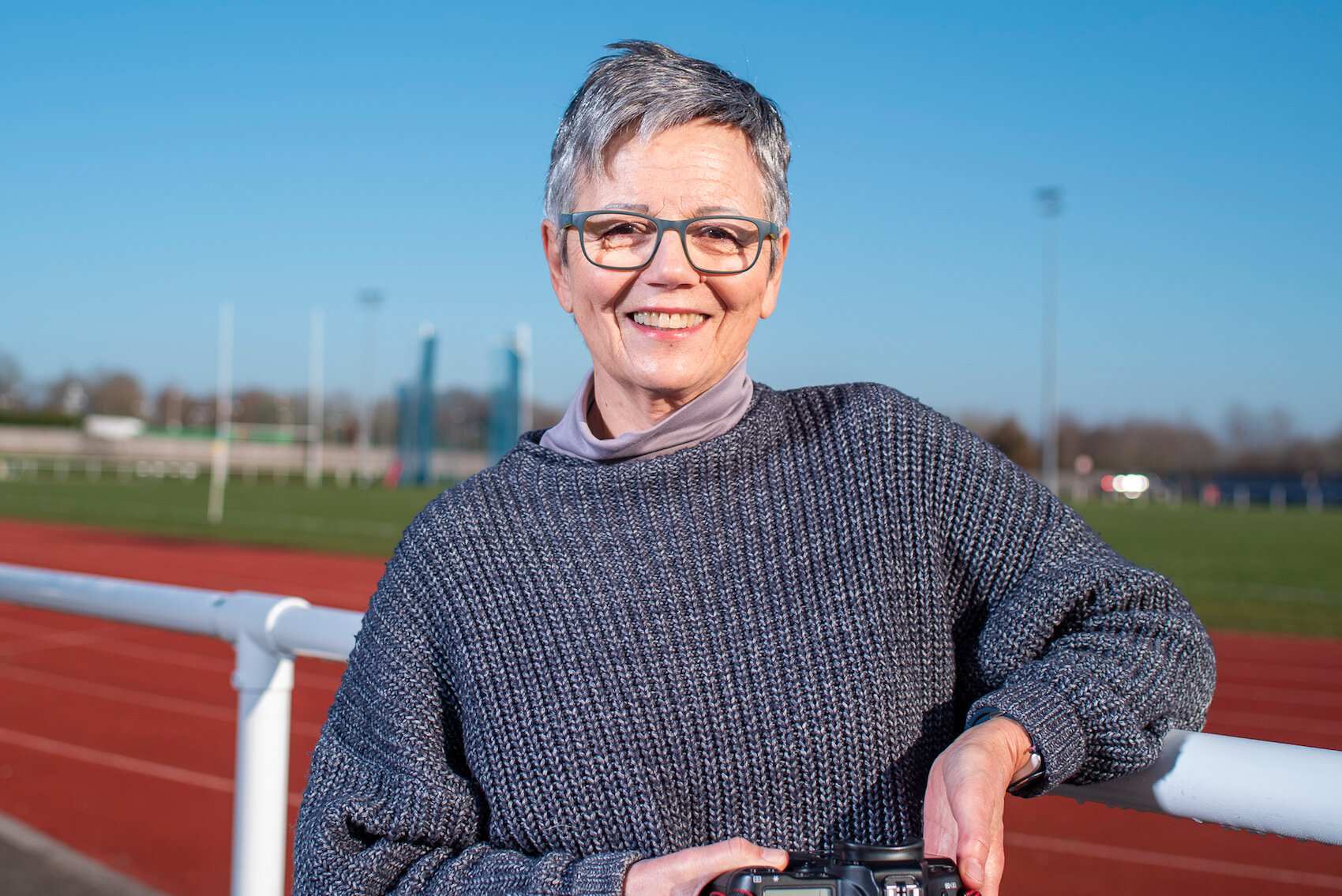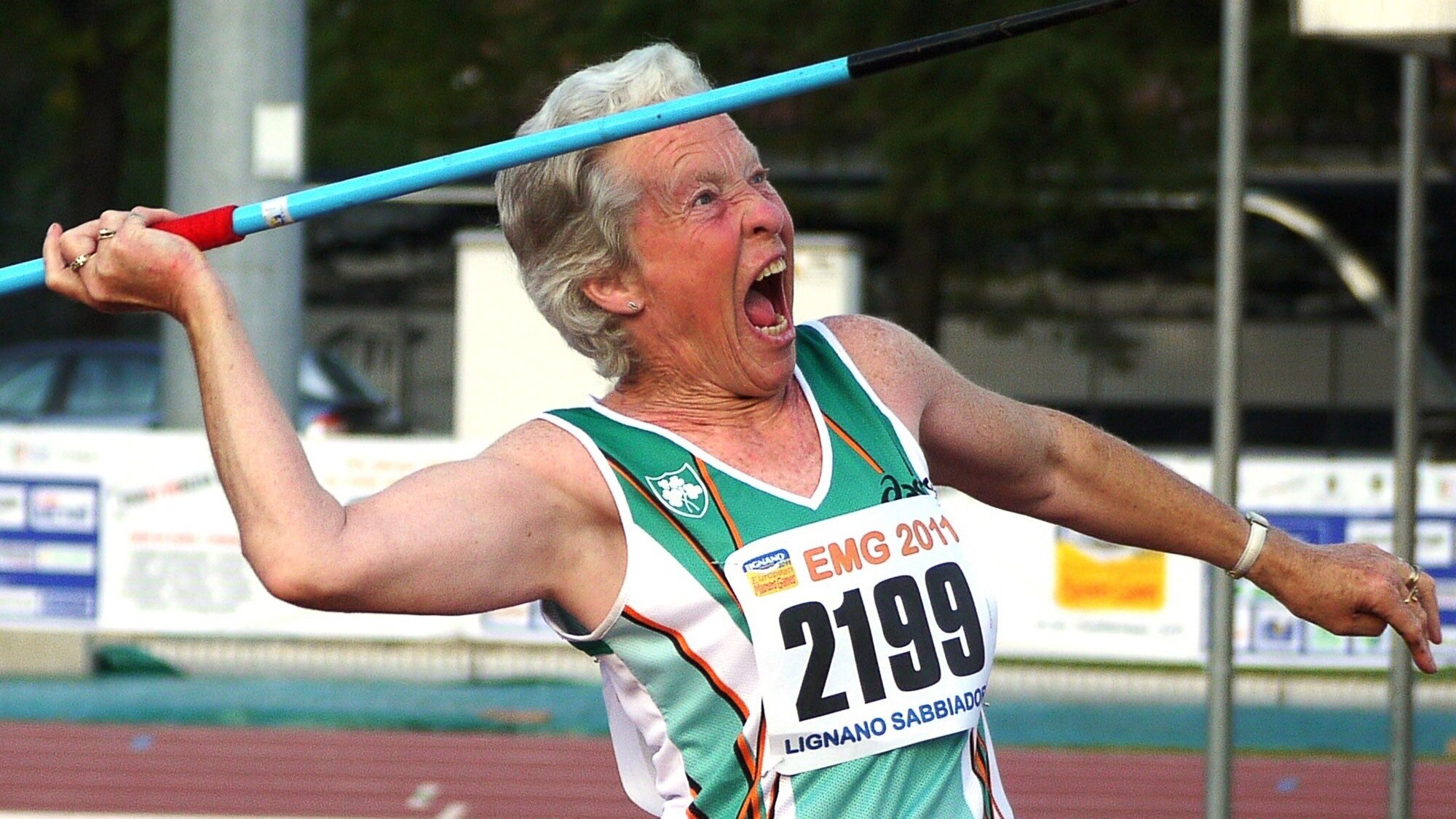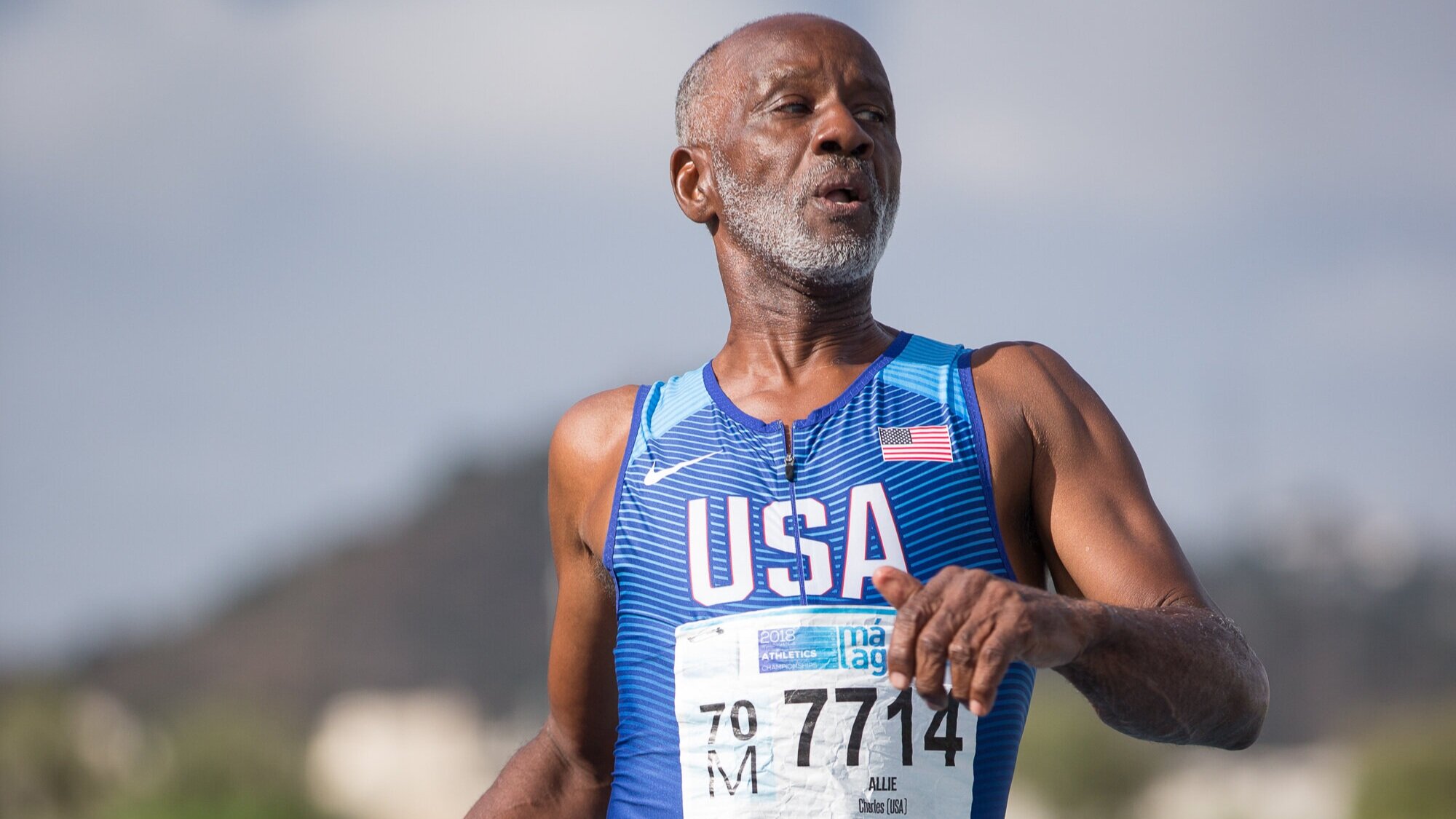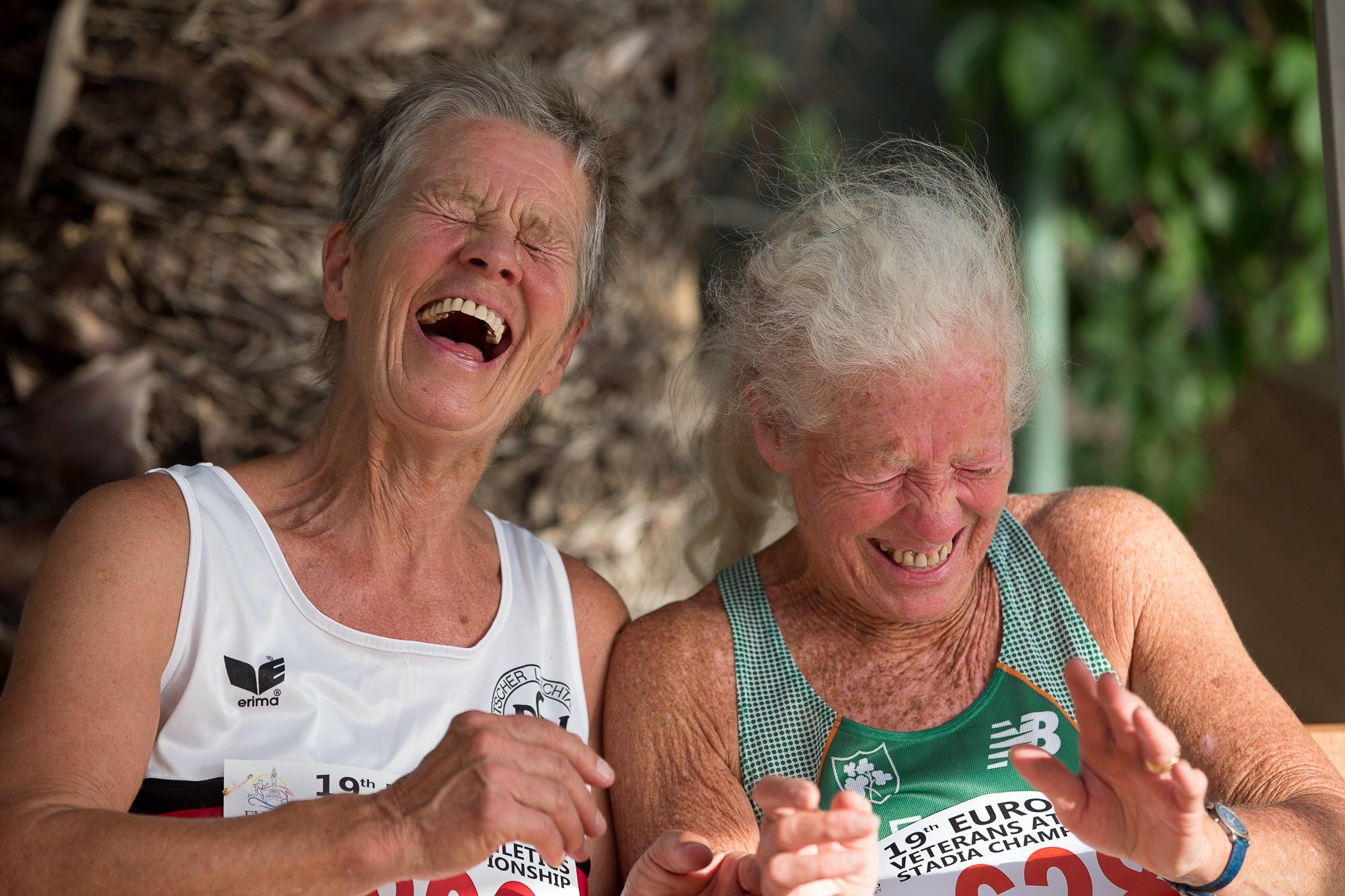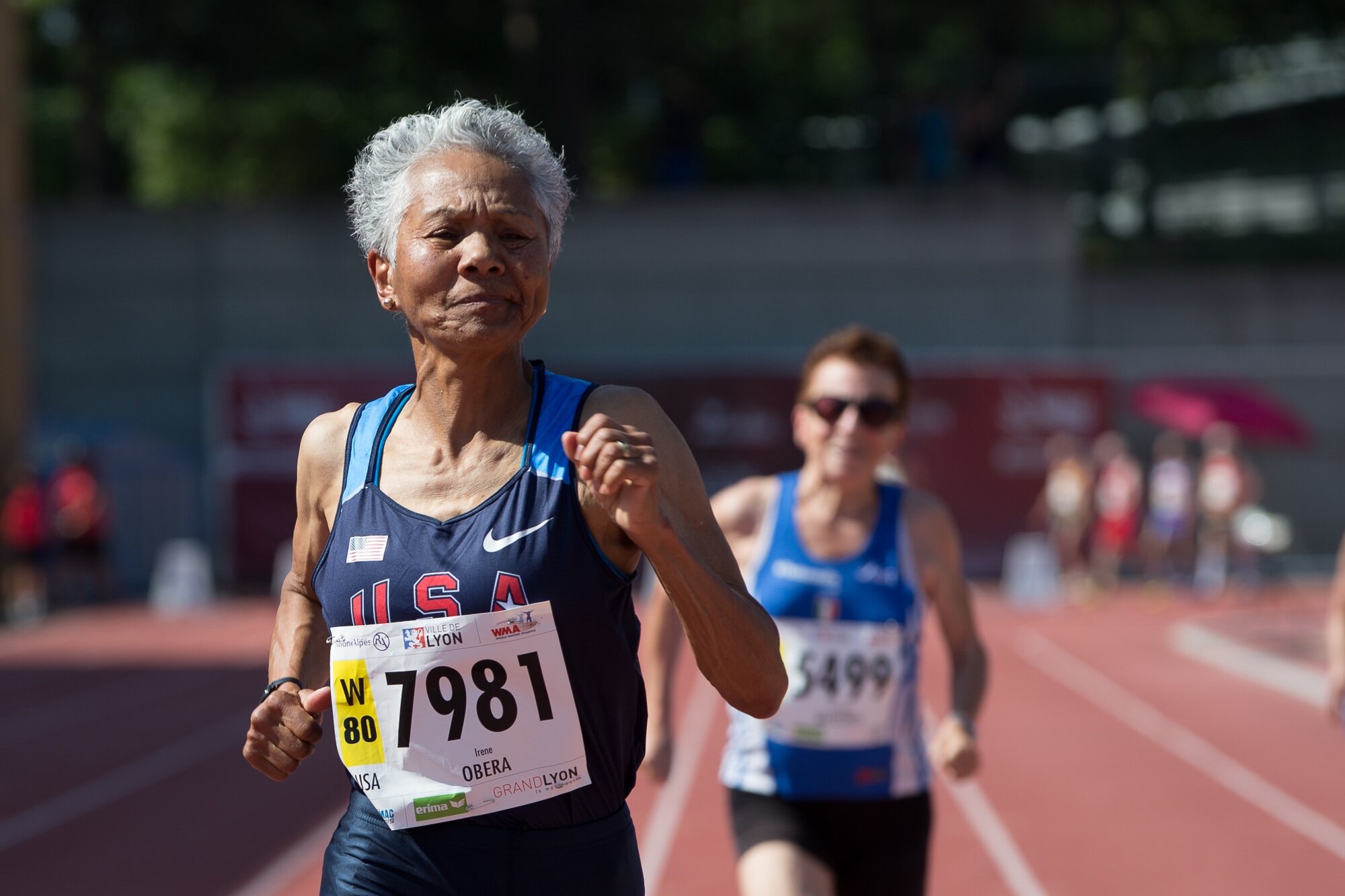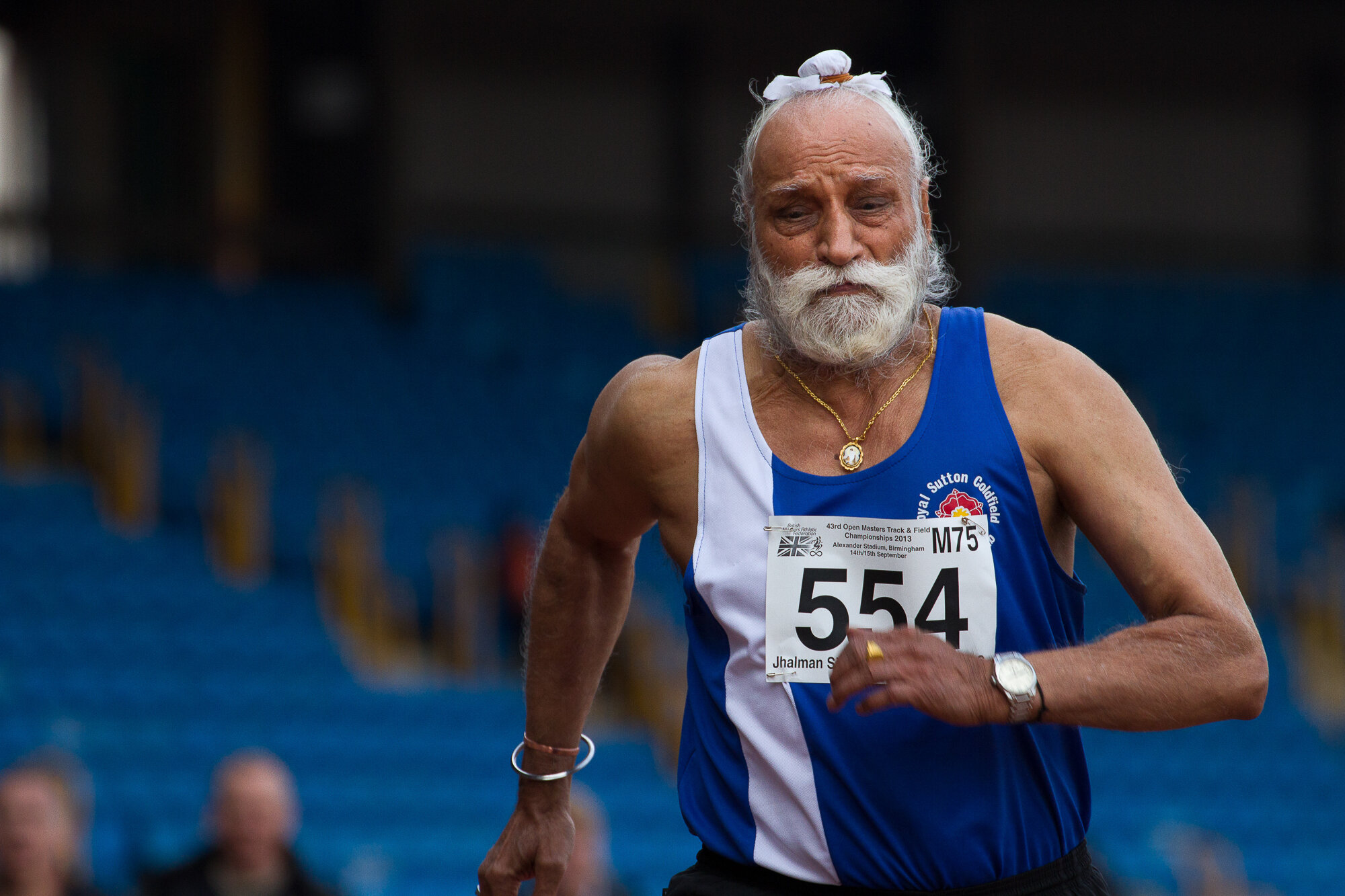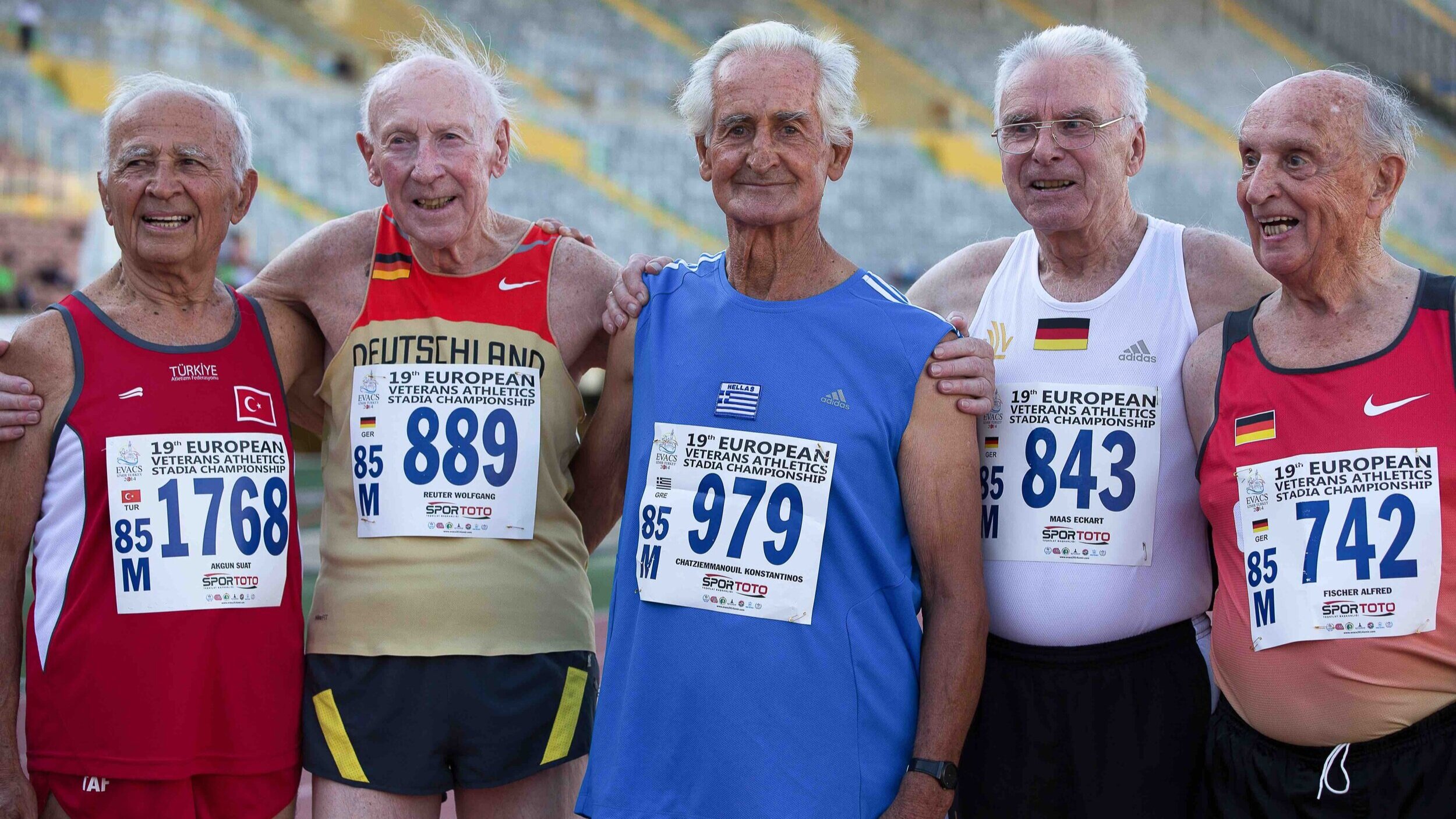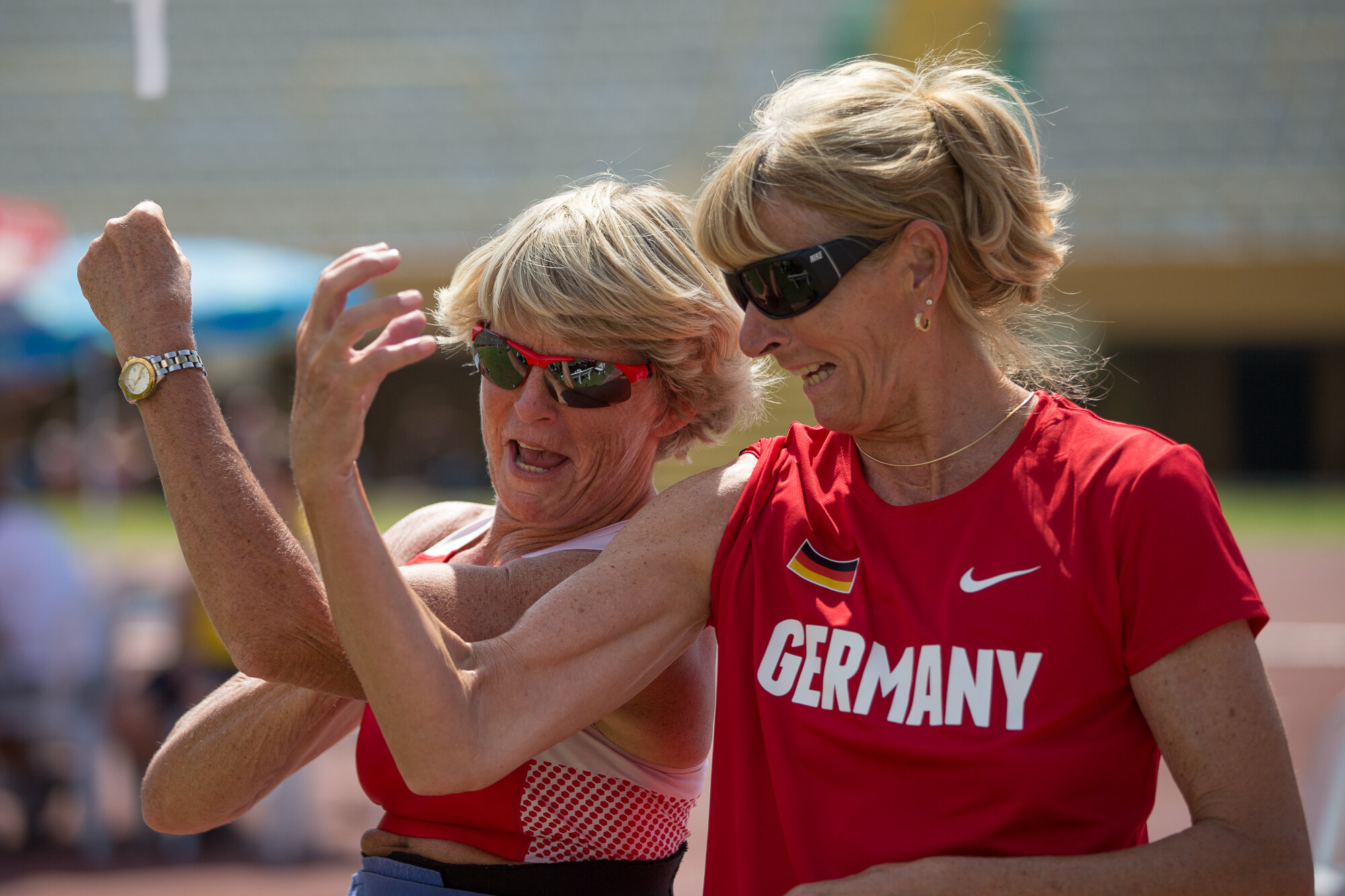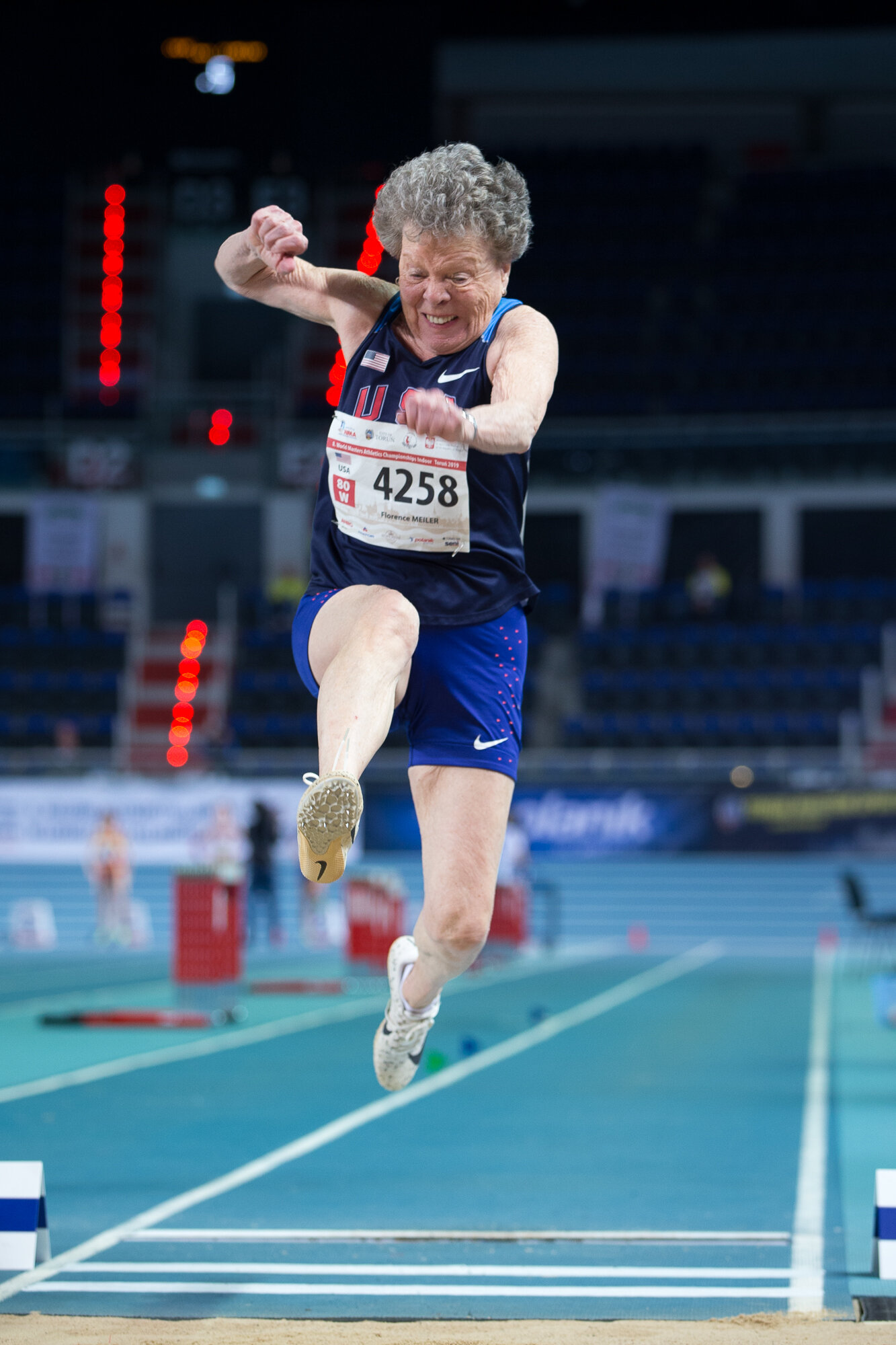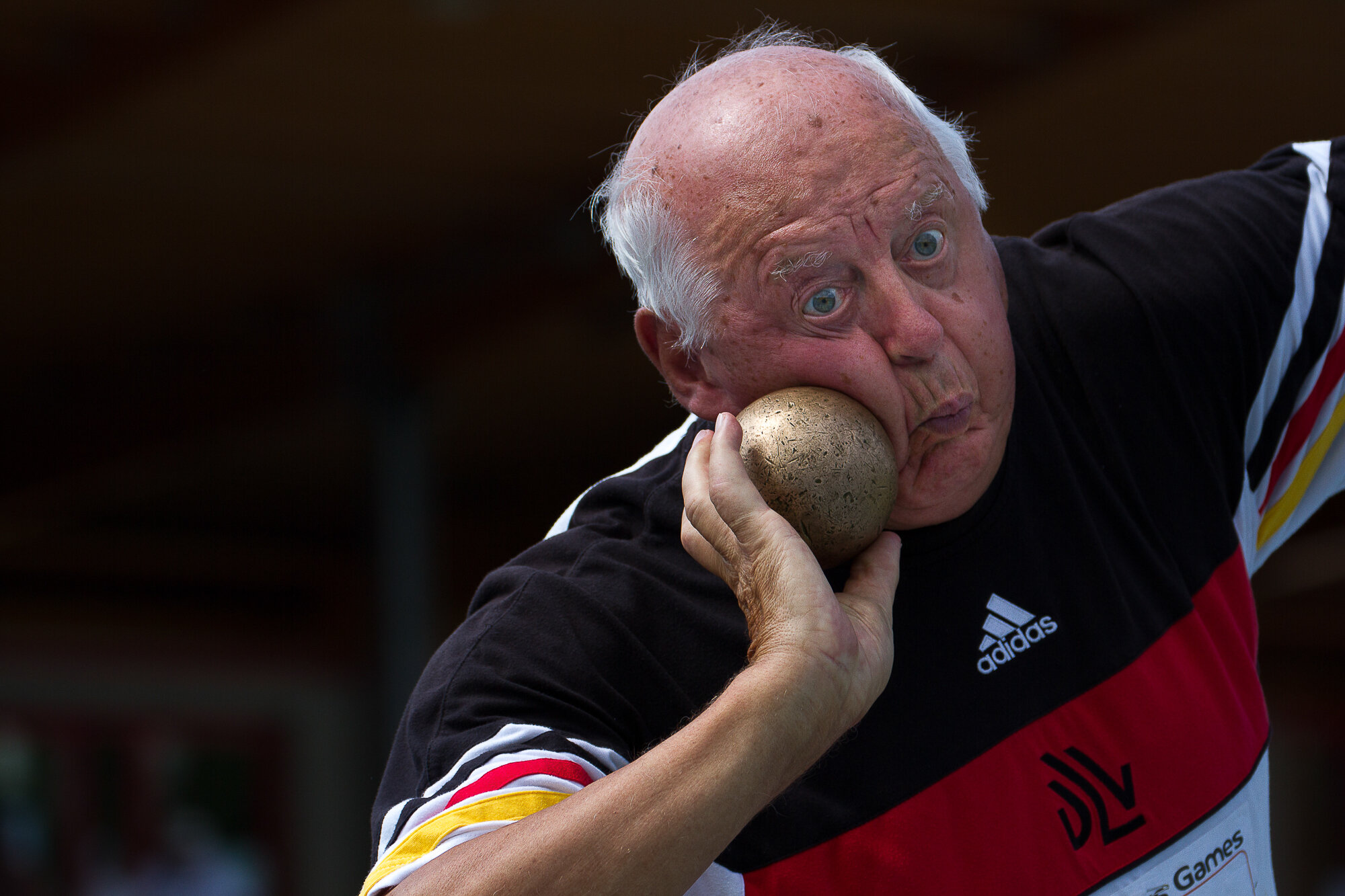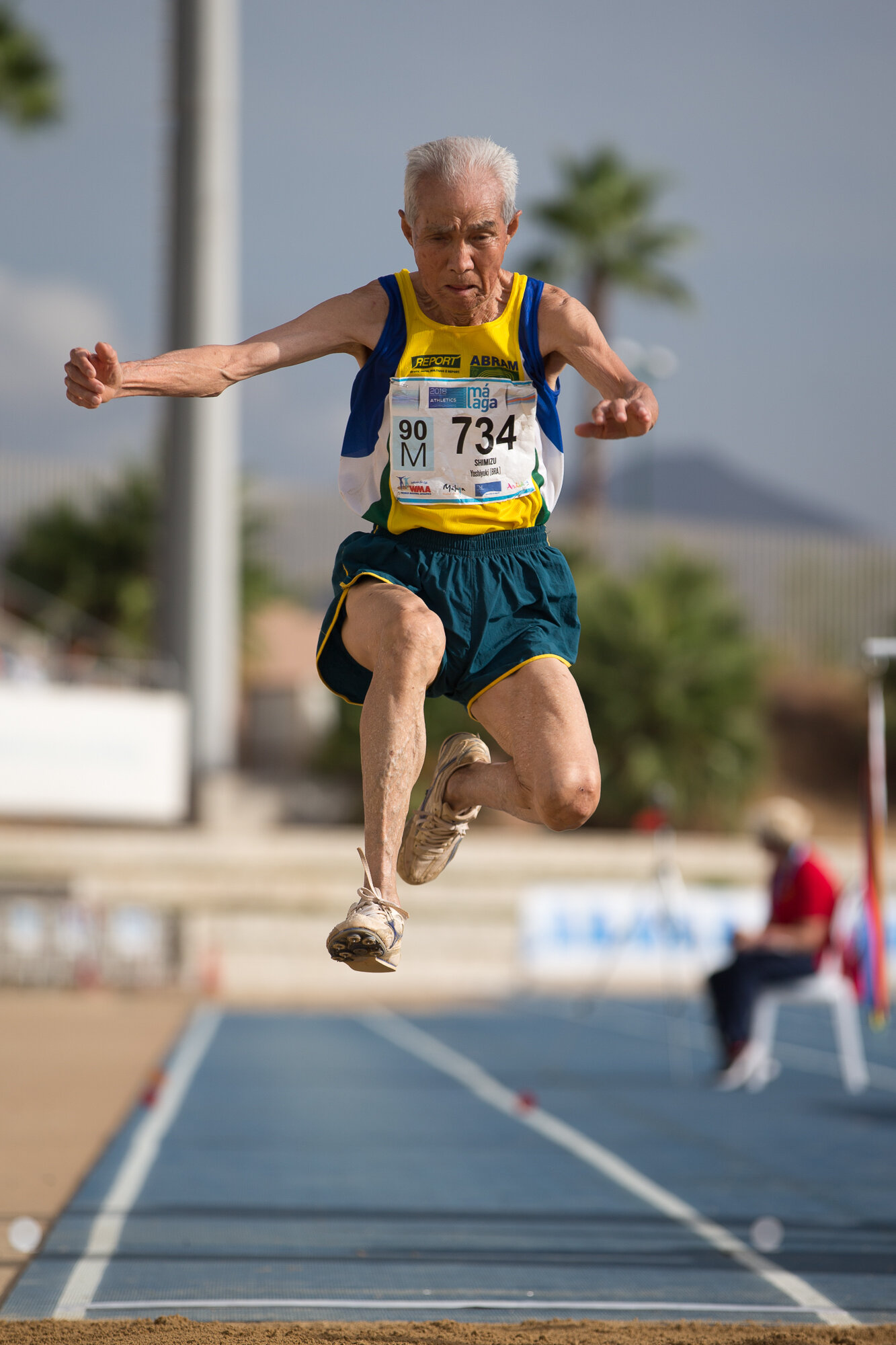Mental attitude is all that counts
We think that it’s always better to look younger. I wanted to show that you can look terrific whatever your age
Alex Rotas, photographer of older competitive athletes, writer, and activist (@Sean Malyon)
Alex Rotas has such a contagious smile, that I’m smiling even while I’m writing her interview. Alex is a dual nationality British and Greek photographer who started a new career in her sixties after she began to notice the current representation of older athletes. As a competitive tennis player herself, she knew that something was missing from the images she saw. She decided to provide the world with more realistic portraits of older athletes. She bought a camera, hired a tutor, hit the track, and began to travel the world, photographing athletes who compete all the way past the age of a hundred.
I feel very close to her work. Although I never felt the call of competitive sports, I always enjoyed challenging myself physically, from morning jogs to insane long-distance walks in the mountain. It was during one of these adventures that I had a taste of the cathartic power of physical endeavors. At the turn of the century, I climbed a 16 thousand foot-high peak in Africa. It took us one week to go from the foot to the top of the mountain and back in an unknown and untamed nature. We had enough food for two meals a day, one tent, and never have encountered a shelter worthy of that name. Because my two companions walked faster than me, it turned out to be an almost solo journey. When we finally reached the rangers hut, they gave us a lift to the village in their Land Rover. Peeking outside the open window, I looked at the red dirt road, lined with dark green, crunchy bushes, and then, mindlessly, I caught a glimpse of my face in the rear mirror. It was me and it was not me, empowered by nature I’d been immersed in, beaming with confidence, transformed by the mountain journey.
I find an echo of that moment in Alex’s pictures (there’s a small gallery at the bottom of this interview, you can click on an image to pop it up in a new window). Her athletes display emotions normally sacrificed on the altar of cultural homogenization. Determination, fatigue, euphoria, joy, but also tenderness, focus, and recklessness. It’s a captivating, intimate view that opens up possibilities we didn’t know existed. But it’s also a collection that - just like my mountain climb - transforms the onlooker. After diving in the depths of Alex’s work, we’ll probably be less likely to feel contented with the sanitized images we’re provided with.
Can you tell us something about your background? What did you do before becoming a sports photographer?
I’ve been lucky enough to have a very varied career path, or paths more like. One thing has led to another and I could never have planned, or even anticipated, how it’s turned out.
I grew up in London and did my undergraduate degree at Cambridge University. In my twenties I lived in Greece, the country of my father’s side of my family, and founded an infant and pre-school centre for hearing-impaired children and their families (I have an American MA in special education). In my thirties I lived in rural Somerset in the UK and worked with pre-school special needs children. In my forties I worked in a hospice setting up their education and training programs. It was through this work that I discovered the power of using visual imagery to encourage people to express difficult emotions such as those related to illness, death, and dying. I’d always been a ‘words person’ until then but once I realized how powerful visual imagery was, I wanted to know more. I went back to university in my fifties where I did an MA and then a PhD in visual culture, something that taught me how to understand images and how to ‘read’ them.
This has helped me enormously since becoming a photographer in my 60s. I may not have known how to take a photograph when I started out but I did know what makes a powerful image. So I knew what I was aiming for.
I learned that you began to question the representation of female and male athletes on the sports pages. What struck you about these photos?
When I was still an academic, in about 2006, I’d started looking at the different images used by male and female tennis players on their websites. Tennis has always been a great love of mine and I used to play international competitive tennis, representing Greece in my youth (I have dual British/Greek nationality). So it was more out of idle curiosity than academic interest that prompted me to check out their websites. But when I did, I was really shocked by what I found and thought it was worth investigating.
The images on the men’s sites showed them playing tennis, competing, and doing their charity work. They had agency, they were the subjects of their life stories. On the female sites, you’d be hard pressed to know that these extraordinary women were tennis players at all. They were all in revealing and/or evening wear, basically inviting an admiring male gaze – not for their skills on court but as objects of desire. I was truly astonished by the extent to which they were objectified (or indeed allowed themselves to be objectified – after all, these were their own websites). It seemed as though they were prouder of being seen as sexually desirable than as one of the top ten tennis players in the world, something I found both shocking and, as a feminist, deeply depressing.
Apart from the fact that you photograph older athletes, how do your images differ from the traditional sports photos?
Traditional sports photos tend (I’m generalizing, obviously) to show full-body shots, often with more of the ‘context’ in the frame than I do. If it’s a race, they might show a group of athletes, or more of the stadium and/or track, for example.
I tend to come in very close: I want to capture the athlete’s face. I want their age to be clearly visible along with their emotions. So many images of older people show them washed out of emotions. I try to capture the focus, the determination, the struggle – yes, the ‘agony and the ecstasy’ of the moment of competition. I also want to show the body, and I like to capture the mixture of muscle and skin tone you get with older athletes. I would never publish a photo that diminished or demeaned an athlete: I want to show how they can look their age (they’re certainly not ‘botoxed’!) and at the same time look full of life and therefore wonderful.
You stressed the importance of representing the essence of an athlete, wrinkles included. Can you elaborate on this?
I was motivated to take photos of older sportsmen and women out of a) my love of sport and b) my desire to pitch in as an activist in the battle against ageism. I wanted to provide an alternative visual narrative around aging to the dominant one that seemed so negative when I started out in 2010.
One of the pernicious, and false, to my mind, ‘givens’ about aging is that it’s always better to look younger than you are. So if someone says “oh, you don’t look 70” (or whatever) to you, it’s meant as a compliment. However, I wanted to show that you can look terrific whatever your age.
Athletes are out in all weathers training. They have the wrinkles to prove it and they look wonderful. How do they look wonderful? Because they are full of life, they’re engaged with life, they’re purposeful, goal-oriented, joyful, and empowered. They are individuals, each with their own unique characteristics, living out the personal stories that make up their lives. I hope that comes across in my photographs.
What is your take on the contemporary visual representation of older adults outside sport?
It’s getting better! Ten years ago, when I started out as a photographer, the standard representation of older people was to show them slumped in chairs in care homes, predominantly looking passive and disempowered. At best they were the smiling and grateful recipients of the care offered them by kind younger people. This of course was, and still is, part of the story, but it is just that: only part, and maybe even a small part, of a bigger, and much more complex and nuanced whole.
Today I’ve just finished reading the June 2020 edition of Vogue UK, which has Judi Dench on the front cover. At 85, she is the oldest person to have been the face of the magazine. And she hasn’t had her wrinkles either botoxed or airbrushed out either! How wonderful is that?
What we are seeing now is more of a discussion around what ‘older’ means and when it starts. People are resisting lumping all ‘over 70s’ together, acknowledging the massive variety of experience in different people’s lives from ages 70 to 100+. It’s as impossible to lump together this whole group as it is to put people from age 10 to 40 in the same category. Assuming teenagers have the same life experiences as 30+-year-olds is clearly ludicrous. Yet creating a lumpen group that puts 70-year-olds with 90-year-olds isn’t met with the same degree of automatic derision. However, if anything, we become more diverse as we age, given the variety of our experiences across the lifespan.
The athletes in your pictures show a lot of emotions, laughter included. The current iconography, on the contrary, tends to black out emotions in the portraits of the older generation. I feel this absence has an impact on our collective perception of aging. What do you think?
I totally agree. As I say, emotions in the imagery of older people are often erased so the person looks vacant. Alternatively, there’s a set-smile and a homogeneity that you see on the faces of the people in many of the stock images used in advertising, in the sale of retirement villages and/or homes, or vitamins, for example. They all have perfect white teeth, just the right amount of tan to their skin, and lots of healthy, sparkling grey hair and they are all relentlessly having fun. They don’t look real.
I love capturing moments of laughter in the sportsmen and women I photograph, it’s true. But I hope that’s where you can see I’ve caught them in a moment of spontaneous joy. They don’t look like models because they aren’t models – they’ve got the imperfections of skin and teeth that we all have – and yet, I believe they look wonderful. They look real because they are real. I’d like viewers to be thinking, “yes please, I’d like some of that!” And it’s not about a product; it’s more about an attitude.
Visual ageism is a stereotyped representation of aging. Professor Loredana Ivan and her colleagues pointed out that even positive visual ageism is harmful. Considering your work, I begin to think that the absence in representation is a form of visual ageism, too. Do you agree?
Do you know, I’d not thought sufficiently about how the absence of representation of older people is in itself a form of visual ageism until you asked this question? And of course it very clearly is just that, you’re totally right. The fact that there are so few varied images of older people in circulation implies a lack of interest, doesn’t it? Why bother to show what older people are doing, “because honestly, who cares?” would seem to be the implicit message.
I hate to be cynical, but now that businesses are waking up to the power of the so-called ‘silver pound/dollar’ there is a growing commercial interest in tapping into older people as a market. I’m coming at it differently, obviously. Challenging ageism and giving voice and space to the stories of older people has got to be in all of our interests. Older people are all of us: they are either those of us over a certain age now or, if they’re lucky, the future selves of everyone else.
And the lives of people older than we are show us possible paths forward for ourselves: they are the torch-bearers. Now that I’m 70, I’m learning from seeing how those in their 80s navigate the thicket – and it’s all thicket as far as I’m concerned. Life is never ‘easy’, the thickets just change as we grow and age, that’s all.
Regarding Professor Loredana Ivan’s interesting comments about ‘visual ageism’, again I totally agree. She’s absolutely on target when she observes that the kind of relentlessly ‘happy/healthy’ (and overwhelmingly very white and middle-class) imagery that I talked about earlier places the onus on the individual to achieve it, disregarding the social factors that affect how we age under hugely varying conditions across both the planet and the life-course. I absolutely agree that what we need are different and more nuanced images to combat what she refers to as the ‘over homogeneity” in the representation of older adults. I hope I’m making a small contribution to this mix.
I am surprised that many of these athletes started to compete later in life. You also had a new beginning past the age of sixty. Is this another secret that the current idea of aging hides from us, therefore influencing our (negative) perception?
Yes, it’s true that a lot of the athletes I photograph either took up track & field after they were 50 or 60 or returned to it after many decades ‘out’ (often they enjoyed competing when they were at school or college but then stopped when work and/or family commitments took over). The late great Canadian athlete Olga Kotelko, who has multiple world records to her name in the 80+ and 90+ age groups and who was still competing right up to her death when she was 95, started from scratch when she was 77. I think that might be something we should all learn from, and not be amused or surprised by. If we have a potential lifespan into our late 90s, that means we’ve 20 years ahead of us when we reach our late 70s, so it’s a perfectly good time to start something new.
I am going to tell more of these storie in a collaborative documentary film project called Maverick Generation with film-maker Danielle Sellwood of Find It Film. We are following five female masters athletes as they train and compete. The protagonist of our pilot short film Pole Vaulter, is Sue Yeomans, a world champion in pole vault age 65-69 category.
What have you learned from the attitude of older athletes and how has this journey in their representation changed your approach to aging?
I’ve learned two main lessons from my work photographing older athletes.
The first is the importance of mental attitude in dealing with whatever life throws at us. They get the same issues that can hit us all as we get older: the same joint problems, cancers, heart issues, strokes, and so on. But they are, in the words of a sprinter in her 80s (who’d been through more than one on that list), “bloody minded.” They have a setback and they get through it; they focus on the other side.
I’m facing a hip replacement at the moment and while my instincts are to think of it as a mountain ahead of me, blocking my way, I’m trying to replace that mental image with one where the mountain is simply something to be crossed. I recently photographed an athlete in her late 60s who’s had both her hips replaced in the last two years. She was competing in the hurdles event! We chatted and she gave me so many wonderful tips but it was her positivity that I came away with most of all. Setbacks may be setbacks. But they’re not catastrophes. This is one massive life-lesson I’m very grateful to have received.
The second lesson I’ve learned is all about the value of community. I know it’s a cliché to talk in terms of a community being ‘family’ but the masters athletics community, both on a national and a world-wide level, truly does feel like just that. I can say this because I seem to have become an adopted member, even though I’m only a photographer and not a competitor. The support and advice I’m receiving with my upcoming hip replacement surgery is a case in point. It’s meant a lot to me – both in terms of the practical advice I’ve received and in terms of the kindness, concern, and solidarity I’ve felt reaching out to me from the community.
This morning I was reading my Facebook feed and an American athlete in her mid-80s had posted about the painful wrist arthritis she suffers, asking for advice. She didn’t want to have to give up her ‘throwing’ events (javelin, discus, shot put). Predictably, lots of tips came in. One comment, from a fellow world-class athlete also in her 80s, stood out for me: “I’m facing many ‘age problems’ too,” she wrote. “I want to continue running, but only to be able to attend meets and see friends. I’m not in shape for much…I’m probably too slow to compete…so maybe we should go, jump around and party afterwards!”
I love this community and I love, and am grateful for, its positivity. Lucky me to have these life-lessons offered to me so generously through the work that I also love doing.
